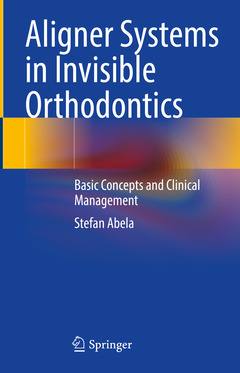Description
Aligner Systems in Invisible Orthodontics, 1st ed. 2024
Basic Concepts and Clinical Management
Author: Abela Stefan
Language: English
Subject for Aligner Systems in Invisible Orthodontics:
411 p. · 15.5x23.5 cm · Hardback
Description
/li>Contents
/li>Biography
/li>Comment
/li>
This comprehensive step-by-step guide on aligner systems is a must have for both dental undergraduate and postgraduate dental students as well as for fully practising clinicians who want to deepen their knowledge in this innovative technique.
Dr Stefan Abela is a specialist in Orthodontics and is registered on the General Dental Council (GDC) specialist list. Stefan has undergone training in various specialties including restorative dentistry, paediatric dentistry, oral medicine and complex oral and maxillofacial surgery including the management of facial trauma as well as study for his post graduate exams for membership into the Royal College of Surgeons of England. Stefan then embarked on his three year, full time specialist training in orthodontics in Cambridge, Norwich and Guy’s and St Thomas’ Hospital, London, gaining a Master in Science degree at King’s College London in 2011. He qualified as a specialist in orthodontics, gaining the Membership in Orthodontics at The Royal College of Surgeons of Edinburgh. He further his studies by gaining a Fellowship with The Royal College of Surgeons Of Edinburhg and he is currently the Head of Orthodontics at Norfolk and Norwich University Teaching Hospital NHS Foundation Trust in the United Kingdom. He is the Chief Execute Officer of two independent practices.
Stefan has carried out various research projects. He practises evidence-based dentistry and instills the same type practice in his teaching practises. He is heavily involved in teaching trainee dental surgeons undergoing specialisation in the UK national specialization programme. Additionally, he is also involved in teaching dental and orthodontic nurses. He has also written and published numerous articles in internationally peer-reviewed journals. Stefan is also an active member of the European Orthodontics Society, and The Higher Education Academy.
Explains the basic concept of aligner systems
Describes the clinical management of the different types of malocclusions with aligner systems
Discusses scientific data and evidence-based approaches in aligner treatment
These books may interest you

Aligner Techniques in Orthodontics 201.38 €



